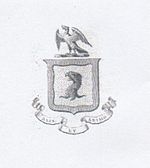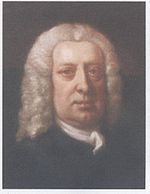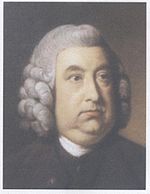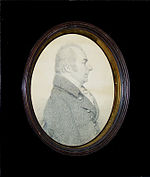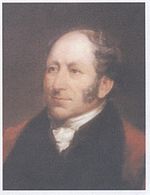- Monro of Fyrish
-
The Monro of Fyrish family were a Scottish family and branch of the ancient highland Clan Munro. The family produced a notable dynasty of doctors to London in the 18th and 19th century where they were involved in early work on curing 'insanity'. Four generations occupied successively the position of (Principle) Physician of the notorious Bethlem Hospital (Bedlam). They were also leading members of a variety of important medical associations. Other members were painters, priests and philanthropists of note and one was an important early patron to J. M. W. Turner.
Contents
Early family history
Hector Munro, 1st of Fyrish was the second son of Robert Munro, 14th Baron of Foulis (d.1547), chief of the Scottish clan, Clan Munro. Hector Munro received as his patrimony the lands of Fyrish, Contullich and Kildermorie in the parish of Alness. He had four sons and one daughter: 1. William Munro, 2nd of Fyrish. 2. John Munro, 3rd of Fyrish. 3. George Munro, who fought in the Thirty Years' War on the European Continent under his chief Robert Munro, 18th Baron of Foulis. George left issue including a son called Hector, who accompanied his father to Germany, where he attained the rank of Captain and acquired an estate in the same country by marriage to a German lady, by who he had a son called Charles Frederick-Von Munro who entered the army and became a Major, in the Regiment of Alsace. 4. Hugh Munro, who married and left one son also named Hugh. 5. Janet Munro, who married Neil Mackay of Achness from the Clan Mackay, with issue.
William Munro, 2nd of Fyrish married Margaret, daughter of Murdoch Mackenzie, 1st of the Fairburn branch of Clan Mackenzie and had one daughter. William was succeeded by his brother John Munro, 3rd of Fyrish who left issue among others: 1. Hugh Munro, 4th of Fyrish. 2. David Munro, who entered the army and rose to the rank of Major but was killed in battle in France before 1653. 3. John Munro.
Hugh Munro, 4th of Fyrish married a distant relative, Isobel Munro, daughter of Robert Munro of Coul and Balconie Castle and left issue: 1. John Munro, 5th of Fyrish, who married Christian, daughter of John Munro, 2nd of Obsdale. 2. Hector Munro. (died young). 3. David Munro, 6th of Fyrish, who married Catherine, daughter of Alexander Munro, 2nd of Daan. 4. The Rev Alexander Monro (educator), 7th of Fyrish. 5. George Munro. 6. Hugh Munro, 1st of Tulloche.
Rev. Alexander Monro, 7th of Fyrish
See main article: Alexander Monro (educator).
Alexander Monro (1648–1698) was the Principal of Edinburgh University from 1685 to 1690. He left only one son, Dr James Monro.
Dr James Monro, 8th of Fyrish
Born 1680, Wemyss. Only surviving son of Alexander Monro (educator), the principal of Edinburgh University by his wife Marion Collace. Educated at Balliol College, Oxford graduating as a physician in 1712. He began his practice as a physician at Greenwich 1713 before moving to London.
In 1728 he was elected Physician to Bethlem Royal Hospital. He became a Fellow of the Royal College of Physicians in 1729 and in 1737 was chosen to present the Harveian Oration. He died on 4 Nov, 1752 at Sunninghill, Berkshire.
Dr James Monro married on 22 Feb, 1707, Elizabeth (died 20 Nov, 1753) the only child of Thomas Hay (died 1734), Solicitor in Chancery and had issue (with others):
1. Dr John Monro, of whom next.
2. Thomas Monro (1716-81), vicar and hospitaller of St Bartholomew the Less, 1754-65, before becoming Rector of Burgate and of Wortham. Married with issue; a number his descendents were in Holy Orders. His second wife was Mary, daughter of Christopher Taylor, Steward of St Bartholomew's Hospital. Thomas married Sarah Jane Hopergood of Hadley and left issue: 1) Horace Monro who entered University College, Oxford in 1816 and graduated B.A in 1820. Horace entered into Holy Orders, was ordained in 1825 and appointed vicar of Kerry, Montgomeryshire. Horace married and had two sons. 2) Vere Monro who also entered University College, Oxford in 1819 and graduated B.A in 1823 and M.A in 1826. He was ordained in 1825 and in 1826 was appointed curate of Stokesley, Diocese of York.
Dr John Monro, 9th of Fyrish
Born 16 Nov, 1715, Greenwich, son of Dr James Monro and Elizabeth Hay. Educated at the Merchant Taylors' School, London then at St John's College, Oxford, where he became a Fellow in 1741 and a Radcliffe Travelling Fellow until 1751. He continued his education at the University of Leyden in 1745, and visited other centres of learning in Europe. In 1747 he was awarded his degree of Doctor of Medicine from University College, Oxford.
In 1751 he was appointed Joint Physician of Bethlehem and Bridewell Hospital (Bethlem Hospital) as an assistant to his father. On his father's death in 1752 he succeeded as Physician of Bethlem Hospital.
Fellow of the Royal College of Physicians in 1753, and acted as Censor on six separate occasions. He delivered the Harveian Oration in 1757. He barely published during his career which was for the most part devoted to the study of insanity for which he was apparently acclaimed for his success.
Dr John Monro retired in January 1783 after an attack of paralysis. He lived at 53 Bedford Square, London, but in 1791 moved to Hadley, near Barnet in co Middlesex and died there 27 Dec, 1791.
On 17 Nov, 1753 he married Elizabeth Culling Smith (died 1802), a sister of Sir William Culling Smith, 1st Baronet, and had, among other issue:
- John Monro (b.1754), who was educated at Merchant Tailor's School, London, from 1769 to 1772 , when he was elected to St John's College, Oxford, where he matriculated on the 30th of June that year and graduated B.A on the 19th of April 1776. He died young in 1779.
- James Monro, 10th of Fyrish.
- Charles Monro (born 1757, died 1821), who was vice-President of the Literary Fund. He married with issue: 1) Charles Munro, a barrister. 2) Hugh Munro, an Ensign in the 1st Foot. 3) John Munro.
- Culling Monro. (died young)
- Dr Thomas Monro FRCP. (see below).
Dr Thomas Monro.
While James Monro continued the senior line of the Monros of Fyrish, his younger brother Thomas Monro continued the family's medical profession: Thomas Monro was born 1759, in London, to Dr John Monro and Elizabeth Culling Smith. Educated at Stanmore School under Samuel Parr, at Harrow and then Oriel College, Oxford where he graduated as a Doctor of Medicine in 1787.
Admitted as a Fellow of the Royal College of Physicians in 1791, and acted as Censor on three separate occasions. He delivered the Harveian Oration in 1799. In 1811 he was named as an Elect of the College.
Like his father and grandfather he was employed at Bedlam, first as Assistant Physician in 1787, then as Principal Physician in 1816 as successor to his father. However, he did not stay in that position long and retired soon after. He attended on King George III in that monarch's last illness.
Dr Thomas Monro was an artist and a patron of other artists. He taught J. M. W. Turner the techniques of tinted drawing[1] and patronized the careers of Turner and of the landscape painter William Henry Hunt. The critic John Ruskin said in his "Notes" on Turner in March 1878, that
-
- "His true master was Dr Monro; to the practical teaching of that first patron and the wise simplicity of method of watercolour study, in which he was disciplined by him and companioned by Giston, the healthy and constant development of the greater power is primarily to be attributed; the greatness of the power itself, it is impossible to over-estimate."
Curiously, Dr Thomas Monro's distant kinsman Hugh Andrew Johnstone Munro of Novar would later be one of Turner's chief patrons.
He died 14 May 1833 at Bushey, Middlesex and was buried in the family vault there. In 1788 he married Hannah, daughter of Rev. Edward Woodcock, DD, the rector of Watford, and had, among other issue:
- Dr Edward Thomas Monro, of whom next.
- Henry Monro (1791–1814), an artist. Exhibited at the Royal Academy in 1811 and 1812, and at the British Institution in 1812. He left a few paintings of note, namely "Othello, Iago and Desdemona" and "The Disgrace of Wolsey" (now in the Tate Gallery), but died at the age of 23. He left a sketch of his father, now in the possession of the National Portrait Gallery.
- Robert Monro (b.1799), educated at Harrow and Merton College, Oxford, where he graduated B.A Second Class in 1819 and M.A Second Class in 1821. He married and left issue.
- Alexander (b.1802), who married with issue.
Dr Edward Thomas Monro
Born November 1789 to Dr Thomas Monro and Hannah Woodcock. Educated at Harrow and Oriel College, Oxford, graduating as Doctor of Medicine in 1814. Joined the Royal College of Physicians in 1816 and was Censor three times. He delivered the Harveian Oration in 1834 and was an Elect in 1842. From 1845 to 1846 he was Treasurer of the Royal College of Physicians.
On his father's resignation in 1816 he was appointed as Principle Physician of Bethlem Hospital, the fourth of his family in direct line to hold that position.
Dr Monro was noted for having attended approximately 400 commissions and trials in lunacy. On only two occasions did his evidence differ from the verdict, and in those cases the decisions were later set aside. His evidence was apparently remarkable for its clearness and force., making him a favourite of lawyers.
Dr Edward Thomas Monro died 25 Jan, 1856. He married on 14 April 1814, Sarah, the daughter of Samuel Compton Cox, a Master in Chancery and Treasurer of the Foundling Hospital. Among other issue, their children included:
1. Rev. Edward Monro (1815–66). Curate of Harrow-on-Weald and Vicar of St John's, Leeds; author of various religious publications. 1852 He was Select Preacher to the University of Oxford. He was noted for his ability for preaching and for his work among the poor of his parishes.
2. Dr Henry Monro, of whom next.
3. Theodore Monro (1819–43). He was the founder of the Convalescent Hospital at Walton-on-Thames, Surrey, one of the first of its type. He married in 1842 Emma, daughter of Sir William Russell, Bt, MD.
- Frederick Thomas Monro (b.1831), who entered Exeter College, Oxford in 1848 and graduated B.A and entered the Civil Service in 1852. He married and left issue.
Dr Henry Monro
Born 10 January 1817 to Dr Edward Thomas Monro and Sarah Cox. Educated at Harrow and Oriel College, Oxford, graduating as Doctor of Medicine in 1863. In 1842 Dr Monro married Jane Eliza, daughter of Sir William Russell, Bt, MD, and had issue by her.
Fellow of the Royal College of Physicians and served as it's Censor and Councillor several times. Member of the Council of the Royal Medical Chirurgical Society. President of the Medical Psychological Association in 1864-65 (now the Royal College of Psychiatrists).
For almost 30 years he was Consulting Physician to St Luke's Hospital, London, another institution which dealt primarily with those deemed to be insane. Dr Henry Monro followed in his family footsteps in dealing with mental health issues and published a variety of works on insanity and as well as stammering.
In I846 he founded the House of Charity at 9 Rose (now Manette) Street, Soho, London (now the House of St Barnabas-in-Soho) and spent forty years at this institution working with the destitute of London. Among those involved in the founding of the House of Charity included the future Prime Minister William Ewart Gladstone and the Roundell Palmer, 1st Earl of Selborne, the Lord Chancellor, the latter serving as honorary secretary along with Dr Henry Monro.[2]
He married on 5 April 1842 Jane Eliza, fourth daughter of Sir William Russel, Baronet M.D of Charlton Park, Gloucestershire, with issue:
- Russell Henry Monro (b.1836), educated at Radley College and University College, Oxford where he graduated B.A in 1868. He married Julia, daughter of Sir George Edmund Nuent of Waddesdon, Baronet, Berkshire.
- Edward William Monro (b.1848), educated at Radley College, Oxford and who married with issue.
- William Charles Monro (b.1849), educated at Radley College, Oxford and who married with issue.
- Frederick Hugh Monro (b.1853), died young.
- Henry Theodore Monro (b.1859), educated at Winchester and Merton College, Oxford and who married with issue.
See also
- Bethlem Hospital
- Royal College of Physicians
- Munro of Auchinbowie
References
- ^ Ian Warrell, in Robert Hewison et al., Ruskin, Turner and the Pre-Raphaelites, Tate Gallery Publishing, 2000, p. 13.
- ^ Soho Square Area: Portland Estate - No. 1 Greek Street: The House of St. Barnabas-in-Soho | British History Online
- Mackenzie, Alexander (2004). History of the Munros of Fowlis. TannerRitchie Publishing, University of St Andrews. ISBN 1554290910.
Categories:- British medical doctors
- Articles about multiple people
- English psychiatrists
- Scottish families
- Clan Munro
- History of mental health in the United Kingdom
Wikimedia Foundation. 2010.

